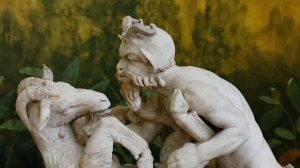We go back more than 1,400 years from the time of Jesus to the Exodus. Apparently, the Israelites began to worship entities during their forty years in the desert called se’irim, or “goat demons.”
And the Lord spoke to Moses, saying, “Speak to Aaron and his sons and to all the people of Israel and say to them, This is the thing that the Lord has commanded. If any one of the house of Israel kills an ox or a lamb or a goat in the camp, or kills it outside the camp, and does not bring it to the entrance of the tent of meeting to offer it as a gift to the Lord in front of the tabernacle of the Lord, bloodguilt shall be imputed to that man. He has shed blood, and that man shall be cut off from among his people. This is to the end that the people of Israel may bring their sacrifices that they sacrifice in the open field, that they may bring them to the Lord, to the priest at the entrance of the tent of meeting, and sacrifice them as sacrifices of peace offerings to the Lord. And the priest shall throw the blood on the altar of the Lord at the entrance of the tent of meeting and burn the fat for a pleasing aroma to the Lord. So they shall no more sacrifice their sacrifices to goat demons, after whom they whore. This shall be a statute forever for them throughout their generations.
Leviticus 17:1–7 (ESV), emphasis added

The se’irim, literally “hairy ones,” were satyr-like (i.e., Pan-like) beings who the Israelites began to worship during their wanderings in the desert. The sacrifices away from the tabernacle were consistent with the worship of Pan. It appears that the section of the Law recorded in Leviticus 17, requiring that all sacrifices be brought to the tent of meeting, was specifically to stop the worship of these goat-demons.
Se’ir is one of those words where the translation depends on the context. Usually, it simply means “goat” or “kid.” But there are four places in the Old Testament where the word clearly refers to a demon or devil. Here’s another example: In Isaiah 34, the prophet turns his polemical gift on the land of Edom:
Thorns shall grow over its strongholds,
Isaiah 34:13–14 (ESV), emphasis added
nettles and thistles in its fortresses.
It shall be the haunt of jackals,
an abode for ostriches.
And wild animals shall meet with hyenas;
the wild goat [sa’ir] shall cry to his fellow;
indeed, there the night bird settles
and finds for herself a resting place.
Again, the “wild goat” is based on the Hebrew root se’ir. The KJV translates the word as “satyr,” as it does in Isaiah 13, but most English translations are similar to the ESV—wild goat, male goat, hairy goat, etc.
Now, back to Moses: The Book of Leviticus records an interesting requirement for the Day of Atonement. It involved a goat that was driven from the camp into the wilderness for a being called Azazel.
“Aaron shall offer the bull as a sin offering for himself and shall make atonement for himself and for his house. Then he shall take the two goats and set them before the Lord at the entrance of the tent of meeting. And Aaron shall cast lots over the two goats, one lot for the Lord and the other lot for Azazel. And Aaron shall present the goat on which the lot fell for the Lord and use it as a sin offering, but the goat on which the lot fell for Azazel shall be presented alive before the Lord to make atonement over it, that it may be sent away into the wilderness to Azazel.
Leviticus 16:6–10 (ESV), emphasis added
Scholars interpret the ritual as complementary rites of atonement, with the sacrificial goat and the second goat who carries the sin of the people away. The priest would lay hands on the goat for Azazel and impart the sins of the people on it before it was led out of the camp and into the wilderness. This is the origin of the term “scapegoat.”
Because you’re paying attention, you remember that the name Azazel has come up before in this series. That’s because the Book of 1 Enoch names Azazel as one of the leaders of the rebellious Watchers who descended at Mount Hermon. And right there is a link between Azazel and the se’irim, the satyr-like deities dancing in the wilderness who just happen to bear a strong resemblance to the Greek god Pan.
Of course, unless you’re a coincidence theorist, you see these details as a connected thread, part of an enemy PSYOP to distract the Jews from their devotion to Yahweh. But that’s not all.
Greek myths record fascinating connections between Pan and a pair of other deities we’ve already encountered in this study: In one story, Pan, in his goat-god aspect Aegipan, assisted Zeus in the chief god’s epic battle with the chaos god, Typhon. When Typhon turned to attack Aegipan, the goat-god dove into the Nile River, with the parts above the water remaining a goat but the part below the waterline transformed into a fish. Thus, Aegipan became the goat-fish Capricornus, or Capricorn.
Even though the constellation Capricorn is faint, it’s been consistently depicted as a hybrid goat-fish since at least the 21st century BC, the time of the last Sumerian kings to rule over all of Mesopotamia. And—here’s the kicker—the goat-fish was a well-known symbol of the god of the abzu, Enki.
So now we can draw links directly from Enki, god of the abyss, to the goat-demons of the Exodus and the goat-god worshiped at the base of Mount Hermon in the time of Jesus Christ.
And it was there at Caesarea Philippi, right outside the Grotto of Pan, where this exchange took place between Jesus and his hot-headed disciple, Peter:
Now when Jesus came into the district of Caesarea Philippi, he asked his disciples, “Who do people say that the Son of Man is?” And they said, “Some say John the Baptist, others say Elijah, and others Jeremiah or one of the prophets.”
He said to them, “But who do you say that I am?” Simon Peter replied, “You are the Christ, the Son of the living God.”
And Jesus answered him, “Blessed are you, Simon Bar-Jonah! For flesh and blood has not revealed this to you, but my Father who is in heaven. And I tell you, you are Peter, and on this rock I will build my church, and the gates of hell shall not prevail against it.“
Matthew 16:13-18 (ESV), emphasis added
Remember that the Grotto of Pan is at the foot of El’s mount of assembly, site of the rebellion by the Watchers. It’s also in Bashan, gateway to the netherworld. Was it a coincidence that it was there Jesus asked Peter, “Who do you say that I am?”
No. Jesus made a statement to the Fallen there, a declaration of his divinity: On their rock, he would build his church!
Then he climbed their rock, Mount Hermon, and was transfigured into a being of light, his face like the sun and his clothes dazzling white—and the disciples heard Yahweh’s voice from heaven.
#
We need to look at one more event that took place in northern Israel, near Mount Hermon. This is in Luke 10, the chapter immediately after Peter’s declaration of faith and the Transfiguration on Mount Hermon. In other words, the time and place of this event was also deliberate.
After this the Lord appointed seventy-two others and sent them on ahead of him, two by two, into every town and place where he himself was about to go. […]
The seventy-two returned with joy, saying, “Lord, even the demons are subject to us in your name!” And he said to them, “I saw Satan fall like lightning from heaven. Behold, I have given you authority to tread on serpents and scorpions, and over all the power of the enemy, and nothing shall hurt you. Nevertheless, do not rejoice in this, that the spirits are subject to you, but rejoice that your names are written in heaven.”
Luke 10:1-20 (ESV)
Now, some translations say there were seventy disciples, others say seventy-two. The Greek manuscripts of Luke are split and there is no way to know for sure which number Luke wrote on his original draft of the gospel. But either way, given the location and the purpose of the mission, there are good theological reasons to believe the number was not, you know, coincidental.
How many sons of El were in El’s assembly on Mount Hermon? That’s right, seventy—plus Ba`al and El equals seventy-two.
How many nations did Yahweh create at the Tower of Babel? Seventy—but some translations of the Bible name seventy-two.
How many elders of Israel climbed Mount Sinai to meet Yahweh face to face? Seventy—plus Moses and Aaron makes seventy-two.
What was the point of Jesus sending the disciples out ahead of him? It was the start of the church’s mission to reclaim the nations from the Fallen, the kickoff event of the Great Commission. Satan, the nachash from the book of Genesis, fell “like lightning from heaven” because he’d lost his legal claim as lord of the dead over those who die in Christ. Why? Because we are guaranteed eternal life through the shedding of his blood.
However you count it, sending out that specific number of disciples wasn’t an accident or a coincidence, it was a clear message to the old gods: Get off my land!


I love this! Thank you. This may be a little off the subject, but I am curious, who would the “night bird” be referenced in Isaiah 34:13,14? Is it another entity?
Thorns shall grow over its strongholds,
nettles and thistles in its fortresses.
It shall be the haunt of jackals,
an abode for ostriches.
And wild animals shall meet with hyenas;
the wild goat [sa’ir] shall cry to his fellow;
indeed, there the NIGHT BIRD settles
and finds for herself a resting place.
Isaiah 34:13–14 (ESV), emphasis added
I read an article the other day that told of Harry Truman having the goat head moved into the white house in connection with his Freemasonry involvement.
Just passing along an experience from a couple years back. A friend had given me an antique mirror with a gold carved border several years back. I didn’t pay attention to the small images around it, I hung it in the front room, one day I noticed the details of the images!!! There were some creepy faces but at the top was Pan! Having no place for this in my home (I saw the visit to the Grotto) I put it in the dumpster. The woman who gave it to me had passed away ,so I don’t know the origin, I am guessing it came out of the early 1900’s.
Great question! The “night bird” in Hebrew is lîlît, or Lilith, which, in context, appears to draw from the Akkadian lilitu, a female wind-demon.